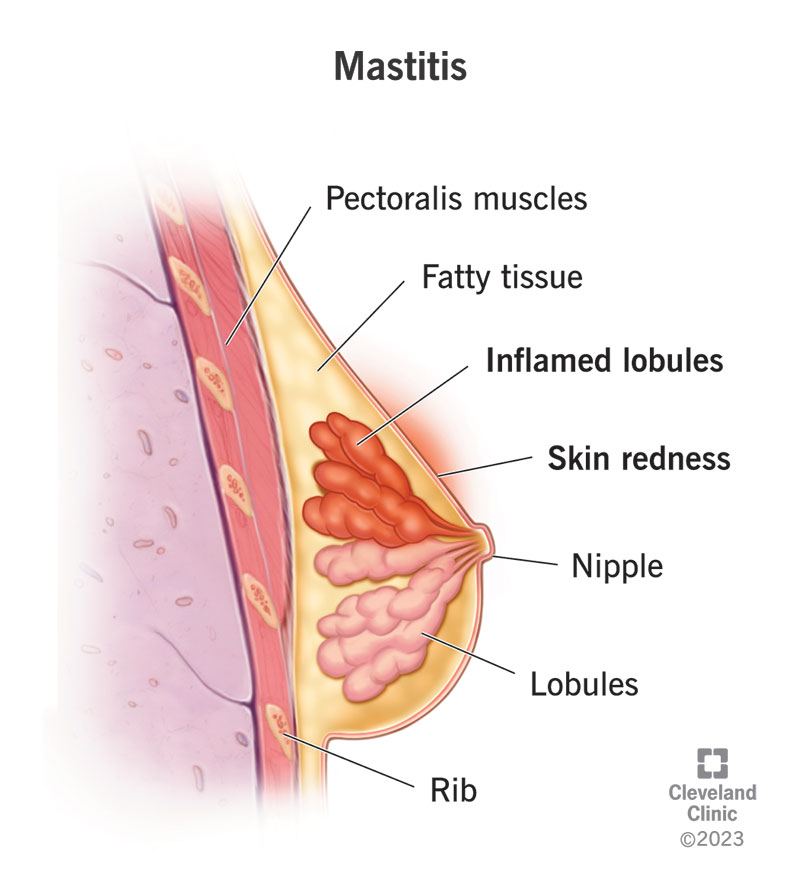
What is Mastitis?
Introduction:
Imagine you’re getting into a groove as a new mom, and then suddenly, your breast feels like it’s on fire. You’re left wondering what’s happening. Mastitis is the culprit. As an IBCLC, I can tell you that mastitis is painful but manageable with the right care and info. We’ll explore what mastitis is, its causes, and how to handle it.
Section 1: What Exactly is Mastitis?
Mastitis is an inflammation of breast tissue that can lead to infection. It’s like your breast is saying, “Hey, something’s off!” Symptoms include redness, swelling, warmth, and tenderness. Some moms might also feel flu-like, adding to their exhaustion.
The inflammation often starts when milk gets trapped in the breast, causing a clogged duct. This can happen for many reasons, like a poor latch, skipped feedings, or tight bras. Think of mastitis as your body’s warning sign.
Section 2: What Causes Mastitis?
Mastitis usually starts when milk isn’t removed effectively, leading to pressure and inflammation. Sometimes, bacteria from the baby’s mouth or skin can enter through a cracked nipple, causing infection.
Here are some common triggers:
- Engorgement: When milk supply outpaces demand, causing a backup.
- Clogged Milk Ducts: Like traffic jams for your milk flow.
- Poor Latch: If your baby isn’t draining the breast well, milk can stagnate.
- Stress and Fatigue: These can weaken your immune system, making you more prone to mastitis.
Quick tip: If you’re feeling stressed, take a deep breath. Your body and baby will thank you!
Section 3: How to Treat and Prevent Mastitis
The good news? Mastitis is treatable, and there are ways to prevent it.
Treating Mastitis:
- Keep Nursing: Yes, it might feel counterintuitive when your breast is sore, but frequent nursing or pumping helps clear the blockage.
- Apply Cold Compresses: Contrary to old advice, cold is your new best friend. It reduces inflammation and eases pain.
- Gentle Massage: Think of it as a mini spa day for your breast. Use gentle pressure toward the nipple to encourage milk flow.
- Rest and Hydrate: You’re not just feeding your baby; you’re fighting off an infection. Rest and water are your allies.
- See Your Healthcare Provider: If symptoms don’t improve in 24-48 hours or if you have a high fever, you might need antibiotics.
Preventing Mastitis:
- Empty your breasts regularly by nursing or pumping.
- Ensure a good latch with every feed. (Reach out to your favorite IBCLC—hint, hint—for help!)
- Avoid tight bras or clothing that can restrict milk flow.
- Practice good nipple care to prevent cracks and soreness.
Section 4: Encouragement for Moms Experiencing Mastitis
Let’s be real: mastitis isn’t fun. But it doesn’t mean you’re failing at breastfeeding or motherhood. It’s just a little bump in the road. Remember, your body is amazing—it grew a human and now nourishes them! Take this as a sign to slow down, ask for help, and take care of yourself.
If you’re feeling overwhelmed, know you’re not alone. Mastitis is common among moms and can be fixed. Reach out to your support system, like your partner, friends, or an IBCLC (that’s me!).
Conclusion:
Mastitis might be a challenge, but it’s fixable with the right care. Nurse or pump often, rest, and ask for help if needed. Your breastfeeding journey is unique, and mastitis is just a part of it.
As your IBCLC cheerleader, I’m here to help every step of the way. Got questions about mastitis or breastfeeding? Comment below, share this post, or book a consultation. We’re in this together!
FAQs about Mastitis
Mastitis is a common concern for breastfeeding moms. Here are some frequently asked questions to help:
1. Can I continue breastfeeding if I have mastitis?
Yes, you should keep breastfeeding with mastitis. It helps clear the infection and keeps milk flowing. It’s safe for your baby and helps you recover.
2. What are the main symptoms of mastitis?
The main symptoms include breast tenderness, redness, warmth, swelling, and pain. You might also feel flu-like symptoms like fever and chills. Catching these symptoms early helps with treatment.
3. How is mastitis treated?
Mastitis is treated with antibiotics and pain relievers. It’s key to finish all antibiotics to clear the infection. Also, keep breastfeeding or pumping to help clear the infection.
4. Can mastitis lead to complications if left untreated?
Yes, untreated mastitis can lead to complications like a breast abscess. This is a collection of pus that might need surgery. Early treatment is crucial to avoid this.
5. Are there ways to prevent mastitis?
Preventing mastitis involves good breastfeeding techniques, frequent feeding, and avoiding tight bras. Proper nipple care and managing stress are also key.
